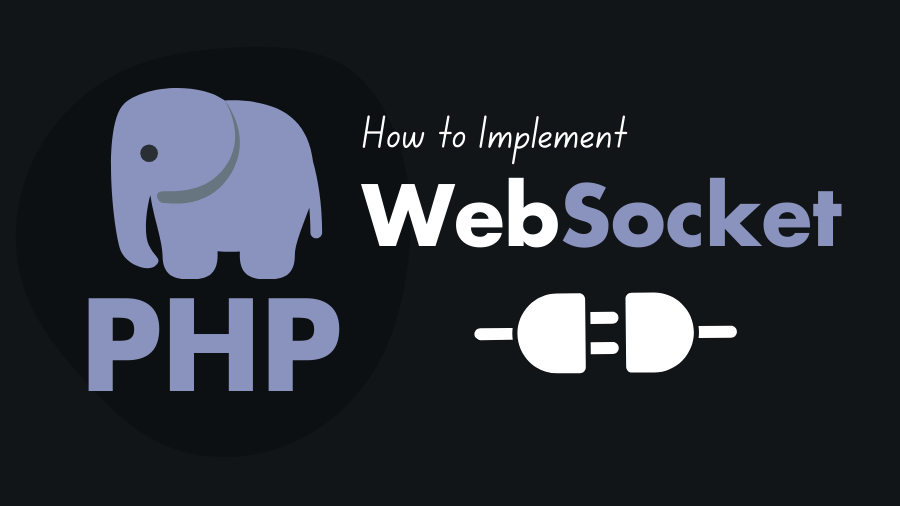Using WebSocket with PHP typically involves integrating a WebSocket server library into your PHP application. There are several WebSocket server libraries available for PHP, such as Ratchet and PHP-Websockets, which you can use to implement WebSocket functionality. In this step-by-step tutorial, you will learn how to implement websocket using the PHP Ratchet library.
4 Steps to Implement WebSocket in PHP
Here’s a basic overview of how to use WebSocket with PHP using the Ratchet library:
1. Install Ratchet
You can install Ratchet using Composer, a dependency manager for PHP. Run the following command in your project directory to install Ratchet:
composer require cboden/ratchet2. Create a WebSocket Server (websocket.php)
<?php
// Including the Composer autoloader to autoload necessary classes
require __DIR__ . '/vendor/autoload.php';
use Ratchet\MessageComponentInterface;
use Ratchet\ConnectionInterface;
// Define a class for the WebSocket server that implements the Ratchet MessageComponentInterface
class WebSocketServer implements MessageComponentInterface
{
protected $clients; // Stores all connected clients
// Constructor to initialize the connected clients storage
public function __construct()
{
$this->clients = new \SplObjectStorage; // SplObjectStorage is used to store connected clients
}
// This method is called when a new connection is established
public function onOpen(ConnectionInterface $conn)
{
echo "New connection! ({$conn->resourceId})\n"; // Print a message indicating a new connection
$this->clients->attach($conn); // Add the new connection to the list of connected clients
}
// This method is called when a message is received from a client
public function onMessage(ConnectionInterface $from, $msg)
{
// Broadcast the received message to all connected clients
foreach ($this->clients as $client) {
$client->send("Message from server: " . $msg);
}
}
// This method is called when a connection is closed
public function onClose(ConnectionInterface $conn)
{
echo "Connection {$conn->resourceId} has disconnected\n"; // Print a message indicating a disconnection
$this->clients->detach($conn); // Remove the disconnected connection from the list of clients
}
// This method is called when an error occurs on a connection
public function onError(ConnectionInterface $conn, \Exception $e)
{
echo "An error has occurred: {$e->getMessage()}\n"; // Print an error message
$conn->close(); // Close the connection where the error occurred
}
}
// Create a new Ratchet application on localhost:8080
$app = new Ratchet\App('localhost', 8080);
// Route requests to the '/server1' endpoint to the WebSocketServer class
$app->route('/server1', new WebSocketServer, array('*'));
// Run the Ratchet application
$app->run();This script creates a WebSocket server listening on port 8080 and routes requests to the /server1 endpoint. It implements the MessageComponentInterface to handle WebSocket events such as connection opening, message receiving, connection closing, and errors.
3. Run the WebSocket Server
Save the script as websocket.php and run it using PHP from the command line:
php websocket.php4. Connect to the WebSocket Server
Once the WebSocket server is running, you can connect to it from a WebSocket client, such as a web browser or another application, using the WebSocket protocol. For example, in JavaScript, you can use the WebSocket API:
<!DOCTYPE html>
<html>
<head>
<title>WebSocket Testing</title>
</head>
<body>
<h1>Open the Console</h1>
<script>
// Create a new WebSocket connection to the server
const ws = new WebSocket("ws://localhost:8080/server1");
// Event handler called when the WebSocket connection is successfully opened
ws.onopen = function () {
// Log a message indicating the successful connection
console.log("Connected to WebSocket server");
// Send a message to the server
ws.send("Hello, WebSocket server!");
};
// Event handler called when a message is received from the server
ws.onmessage = function (event) {
// Log the message received from the server
console.log(event.data);
};
// Event handler called when the WebSocket connection is closed
ws.onclose = function () {
// Log a message indicating the disconnection
console.log("Disconnected from WebSocket server");
};
</script>
</body>
</html>That’s a basic overview of using WebSocket with PHP using the Ratchet library. You can extend this example to build more complex WebSocket applications with features like authentication, broadcasting messages to specific clients, and handling different types of messages.
Is PHP the best choice to implement WebSocket?
PHP is not typically considered the best choice for implementing WebSocket functionality, especially in high-performance or real-time applications. While PHP has libraries and extensions available for WebSocket, such as Ratchet or PHPWebSocket, it’s not as well-suited for handling long-lived connections and real-time data transfer compared to other languages like Node.js, Python, or Java.
PHP traditionally follows a request-response model, where a client sends a request to the server, the server processes it, and then sends a response back to the client, which is not the ideal model for WebSocket communication, where connections are kept open for extended periods of time.
That said, if you’re already working within a PHP ecosystem and need to implement WebSocket functionality, you can certainly do so with libraries like Ratchet. However, for more complex or high-performance WebSocket applications, you might find other languages like Node.js or Python more suitable. These languages are designed with event-driven, asynchronous architectures that are better suited for handling WebSocket connections and real-time communication.
